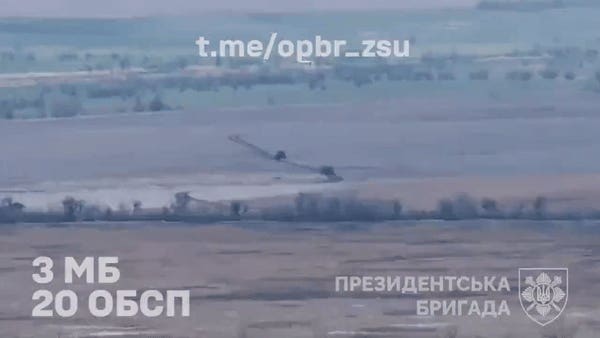The Ukrainian Presidential Brigade hits a Russian vehicle near Velyka Novosilka.
Presidential Brigade capture
Ukrainian troops attacked on Sunday, retaking ground they recently lost around the town of Velyka Novosilka in southern Donetsk Oblast.
It was one of several small-scale Ukrainian counterattacks in recent days—and fleeting good news for Ukrainian forces as a yearlong Russian offensive culminates in Donetsk.
The problem for the Ukrainians is that their attack occurred along a section of the front that isn’t actually critical for either Ukraine or Russia. The Kremlin is focused on capturing the fortress city of Pokrovsk, 30 miles to the north.
“Russia has made gradual gains toward Pokrovsk,” the U.K. Defense Ministry noted. Today the Russians are just four miles from the city itself, according to the ministry. The coming Russian siege doesn’t depend on which side controls Velyka Novosilka and surrounding villages.
It might depend on Russian troops eliminating Ukrainian-held salients around Kurakhove, 20 miles east of Velyka Novosilka. The main salient, nine miles deep at its deepest, juts into the front line toward Dalnje, just south of Kurakhove. Ukrainian forces in the salient could threaten the supply lines supporting Russian forces advancing on Pokrovsk to the north.
There are elements of at least eight battalions and four brigades in the Dalnje salient: no more than 10,000 Ukrainian troops, assuming all the units are at full strength. But as many as nine Russian regiments and brigades with a maximum strength of up to 18,000 troops surround the salient.
Ukraine Control Map
“Russian forces have continued to use frontal mechanized and dismounted infantry assaults to advance slowly but gradually into eastern and central Kurakhove and south of Kurakhove into Dalnje, which supports larger Russian efforts to eliminate the remaining Ukrainian pocket between Dalnje and Kurakhove,” the Institute for the Study of War in Washington, D.C. reported.
The worst-case scenario for Ukraine is a Russian force cutting across the salient between Bahatyr in the south and Novotroitske in the north and cutting off the Ukrainians to the east. “There is a real threat of encirclement,” the Ukrainian Center for Defense Strategies warned.
The only slightly worse scenario is a coordinated Ukrainian withdrawal from the salient that preserves the Ukrainian force but still allows the Russians to straighten the front line from south to north all the way from Velyka Novosilka to Pokrovsk. By straightening the line, the Russians would reduce threats to their flanks as they finally lay siege to Pokrovsk.
If the Ukrainians hang on in the salient, the Russians may choose to accept the risk to their flanks and attack Pokrovsk anyway. How soon the siege might begin depends on a lot of factors. Winter weather could interfere. Deepening Russian losses in western Russia’s Kursk Oblast could sap the Russians’ overall strength.
On the other hand, the incoming administration of U.S. President-elect Donald Trump could cut off U.S. aid to Ukraine and deprive Ukrainian forces of critical ammunition starting next month.
The coming weeks should determine how the Russians attack Pokrovsk. Whether they’ll attack is already pretty clear. “The upcoming battle for Pokrovsk will mark the apex of the enemy’s offensive operation in the southwestern theater of operations in 2024,” CDS predicted.
A small Ukrainian attack around Velyka Novosilka can’t stop the much bigger—and likely inevitable—Russian attack on Pokrovsk.
